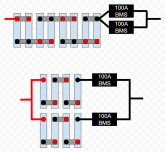jaffadog
New Member
- Joined
- Mar 1, 2020
- Messages
- 34
Hello All,
I have 8 100AH Fortune cells that i need to put together for a 12v system. It needs to be able to handle 200A peek loads. Normal loads will be well below 100A. I like Will's recommended JBD BMS - but capacity is limited to 120A (maybe 130A peek). So I am considering using 2 BMSs. I could either put both BMSs on a single 2P4S battery with the balance leads doubled up on the same 5 tap points on the battery, or just construct 2 separate 4S batteries each with their own dedicated BMS. I like the simplicity and physical density of putting together a single 2P4S battery. The parallel BMS arrangement is unconventional, but I think it would work. Thoughts?

Cheers,
Jeremy
I have 8 100AH Fortune cells that i need to put together for a 12v system. It needs to be able to handle 200A peek loads. Normal loads will be well below 100A. I like Will's recommended JBD BMS - but capacity is limited to 120A (maybe 130A peek). So I am considering using 2 BMSs. I could either put both BMSs on a single 2P4S battery with the balance leads doubled up on the same 5 tap points on the battery, or just construct 2 separate 4S batteries each with their own dedicated BMS. I like the simplicity and physical density of putting together a single 2P4S battery. The parallel BMS arrangement is unconventional, but I think it would work. Thoughts?

Cheers,
Jeremy


